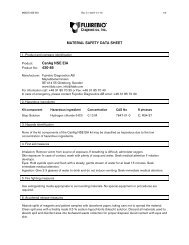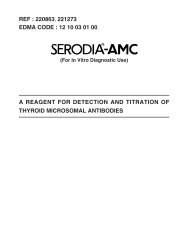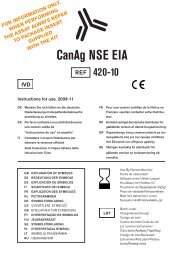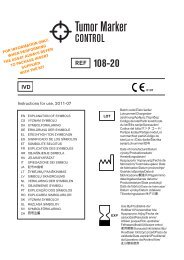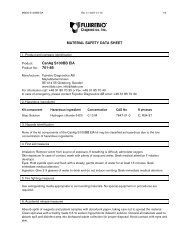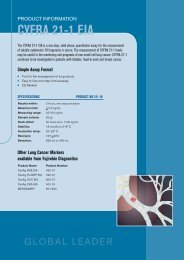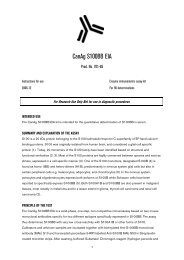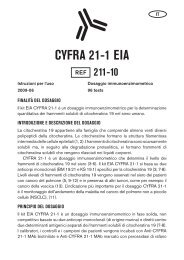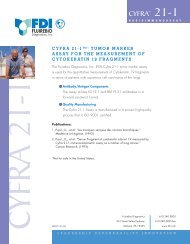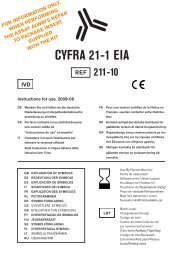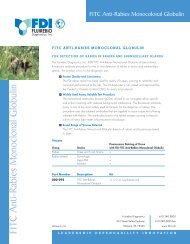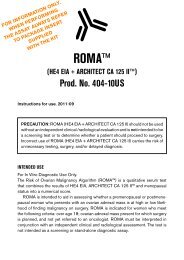CanAg ProGRP EIA 220-10 - Fujirebio Diagnostics, Inc.
CanAg ProGRP EIA 220-10 - Fujirebio Diagnostics, Inc.
CanAg ProGRP EIA 220-10 - Fujirebio Diagnostics, Inc.
Create successful ePaper yourself
Turn your PDF publications into a flip-book with our unique Google optimized e-Paper software.
FOR INFORMATION ONLY.<br />
WHEN PERFORMING<br />
THE ASSAY ALWAYS REFER<br />
TO PACKAGE INSERT<br />
SUPPLIED<br />
WITH THE KIT<br />
IVD<br />
<strong>CanAg</strong> <strong>ProGRP</strong> <strong>EIA</strong><br />
REF <strong>220</strong>-<strong>10</strong><br />
Instructions for use. 2011-09<br />
EN<br />
BG<br />
CS<br />
DA<br />
DE<br />
EL<br />
ES<br />
ET<br />
FR<br />
HR<br />
HU<br />
IT<br />
LT<br />
LV<br />
NL<br />
NO<br />
PL<br />
PT<br />
RO<br />
RU<br />
SE<br />
SK<br />
SL<br />
SR<br />
TR<br />
EXPLANATION OF SYMBOLS<br />
ОБЯСНЕНИЕ НА СИМВОЛИТЕ<br />
VÝZNAM SYMBOLŮ<br />
SYMBOLFORKLARING<br />
ERKLÄRUNG DER SYMBOLE<br />
ΕΠΕΞΗΓΗΣΗ ΤΩΝ ΣΥΜΒΟΛΩΝ<br />
SIGNIFICADO DE LOS SÍMBOLOS<br />
SÜMBOLITE SELGITUS<br />
EXPLICATION DES SYMBOLES<br />
OBJAŠNJENJE SIMBOLA<br />
JELMAGYARÁZAT<br />
SPIEGAZIONE DEI SIMBOLI<br />
SimboLIŲ paaiškinimai<br />
SIMBOLU SKAIDROJUMS<br />
VERKLARING DER SYMBOLEN<br />
SYMBOLFORKLARING<br />
OBJAŚNIENIE SYMBOLI<br />
EXPLICAÇÃO DOS SÍMBOLOS<br />
SEMNIFICAŢIA SIMBOLURILOR<br />
Обоначения<br />
SYMBOLFÖRKLARING<br />
VÝZNAM SYMBOLOV<br />
RAZLAGA SIMBOLOV<br />
OBJAŠNJENJE SIMBOLA<br />
SEMBOLLERİN AÇIKLAMALARI<br />
Use By/Годно до/Použitelné do/<br />
Holdbar til/Verwendbar bis/<br />
Ημερομηνία λήξης/Fecha<br />
de caducidad/Kõlblik kuni/<br />
Utiliser jusque/Rok valjanosti/<br />
Felhasználható/Utilizzare entro/<br />
Sunaudoti iki/Izlietot līdz/Houdbaar<br />
tot/Brukes innen/Użyć przed/<br />
Prazo de validade/Expiră la/<br />
Использовать до/Använd före/<br />
Použite´né do/ Uporabno do/<br />
Upotrebljivo do/Son Kullanma Tarihi<br />
Batch code/Номер на партида/<br />
Číslo šarže/Lotnummer/<br />
Chargenbezeichnung/Αριθμός<br />
Παρτίδας/Código de lote/Partii<br />
kood/Code du lot/Kod serije/<br />
Sarzsszám/Codice del lotto/<br />
Partijos kodas/Partijas kods/Lot<br />
nummer/Partikode/Kod partii/<br />
Código do lote/Număr de lot/<br />
Номер лота/Lotnummer/Číslo<br />
šarže/Številka serije/Kod partije/<br />
Parti Kodu<br />
1
IVD<br />
REF<br />
Date of manufacture/Дата на<br />
производство/Datum výroby/<br />
Produktionsdato/Herstellungsdatum/<br />
2 o C<br />
Ημερομηνία παραγωγής/Fecha de<br />
fabricación/Valmistamise kuupäev/<br />
Date de fabrication/Datum proizvodnje/<br />
Gyártási idő/Data di produzione/<br />
Pagaminimo data/Ražošanas datums/<br />
Productiedatum/Fremstillingsdato/<br />
Data produkcji/Data de fabrico/Data<br />
fabricaţiei/Дата производства/<br />
Tillverkningsdatum/Dátum výroby/Datum<br />
izdelave/Datum proizvodnje/Üretim tarihi<br />
In Vitro Diagnostic Medical Device/<br />
Медицински уред за диагностика<br />
ин витро/Diagnostický zdravotnický<br />
prostředek in vitro/Medicinsk udstyr til<br />
in vitro-diagnostik/In-vitro-Diagnostikum/<br />
Ιατροτεχνολογικό προϊόν για διάγνωση<br />
In Vitro/Dispositivo médico para<br />
diagnóstico in vitro/In vitro diagnostiline<br />
meditsiiniseade/Dispositif médical de<br />
diagnostic in vitro/Diagnostički medicinski<br />
uređaj In Vitro/In vitro orvosdiagnosztikai<br />
eszköz/Dispositivo medico per test<br />
diagnostici in vitro/In Vitro Diagnostinė<br />
Medicinos Priemonė/Medicīniska ierīce<br />
in vitro diagnostikai/In vitro-diagnostisch<br />
medisch instrument/In vitro diagnostisk<br />
medisinsk utstyr/Wyrób medyczny do<br />
diagnostyki in vitro/Dispositivo Médico<br />
de Diagnóstico In Vitro/Dispozitiv medical<br />
pentru diagnostic in vitro/Только для<br />
диагностики In Vitro/Endast för in<br />
vitro-diagnostik/ Zdravotnícka pomôcka na<br />
diagnostiku in vitro/In vitro diagnostični<br />
pripomoček/Diagnostički medicinski<br />
uređaj In Vitro/ testleri için yeterlilik<br />
içerir<br />
Catalogue number/Каталожен номер/<br />
Katalogové číslo/Katalognummer/<br />
Bestellnummer/Αριθμός καταλόγου/<br />
Número de catálogo/Kataloogi number/<br />
Numéro de catalogue/Kataloški broj/<br />
Katalógusszám/Numero di catalogo/<br />
Katalogo numeris/Numurs katalogā/<br />
Catalogusnummer/Katalognummer/<br />
Numer katalogowy/Número do catálogo/<br />
Număr de catalog/Номер по каталогу/<br />
Produktnummer/Katalógové číslo/<br />
Kataloška številka/Kataloški broj/<br />
Katalog numarası<br />
8 o C<br />
Temperature limitation/<br />
Температурни граници/<br />
Teplotní omezení/<br />
Temperaturbegrænsning/<br />
Temperaturbegrenzung/<br />
Περιορισμοί θερμοκρασίας/<br />
Límites de temperatura/<br />
Temperatuuri piirang/<br />
Limite de température/<br />
Temperaturno ograničenje/<br />
Hőmérsékletre vonatkozó korlátozás/<br />
Limiti di temperatura/<br />
Temperatūriniai apribojimai/<br />
Temperatūras ierobežojums/<br />
Temperatuurbeperking/<br />
Temperaturbegrensninger/<br />
Temperatury graniczne/<br />
Limite de temperatura/<br />
Limite de temperatură/<br />
Температурный режим/<br />
Temperaturbegränsning/<br />
Teplotné obmedzenie<br />
Omejitev temperature/<br />
Temperaturno ograničenje/<br />
Sıcaklık sınırlaması/<br />
Contains sufficient for tests/Съдържа<br />
достатъчно количество за тестове<br />
/Lze použit pro testů/Indeholder<br />
tilsttrækkeligt/Inhalt ausreichend für <br />
Prüfungen/Περιεχόμενο επαρκές για<br />
«96» εξετάσεις/Contenido suficiente para<br />
ensayos/Kogusest piisab testi<br />
läbiviimiseks/Contenu suffisant pour “96”<br />
tests/Sadrži dovoljno za testova/A<br />
doboz tartalma vizsgálat elvégzéséhez<br />
elegendő/Contenuto sufficiente per “96”<br />
saggi/Turinys skirtas atlikti tyrimus/<br />
Saturs pietiekams testiem/Inhoud<br />
voldoende voor “96” testen/til ”96” test/<br />
Tilstrekkelig innhold for prøver/<br />
Wystarczy na wykonanie testów/<br />
Conteúdo suficiente para “96” ensaios/<br />
Conţinut suficient pentru 96 de teste/<br />
Содержит достаточные количества для<br />
«96» определений/Innehåller tillräckligt<br />
till “96” antal tester/Obsah postačuje na<br />
tento počet testov: /Vsebina zadostuje<br />
za testov/Sadržina dovoljna za <br />
testova/ testleri için yeterlilik içerir<br />
2
CONT<br />
Consult Instructions for Use/<br />
Прочетете инструкцията за<br />
употреба/Konzultujte s návodem<br />
k použití/Se brugsanvisning/Siehe<br />
Gebrauchsanweisung/Συμβουλευτείτε<br />
τις Οδηγίες σχετικά με τη χρήση/<br />
Consulte las instrucciones de uso/<br />
Vt kasutusjuhendit/Consulter le mode<br />
d’emploi/Pročitajte upute za uporabu/<br />
Olvassa el a használati utasítást/<br />
Consultare le istruzioni per l’uso/Dėl<br />
naudojimo žiūrėkite instrukcijas/Izlasiet<br />
lietošanas instrukciju/Raadpleeg de<br />
instructies voor gebruik/Les instruksene<br />
før bruk/Sprawdzić w instrukcji użycia/<br />
Consulte as Instruções de Utilização/<br />
Consultaţi instrucţiunile de utilizare/<br />
Обратитесь к инструкции по<br />
применению/Se bruksanvisning/<br />
Prečítajte si návod na používanie/<br />
Pročitajte uputstvo za upotrebu/<br />
Kullanım Talimatlarına Bakınız<br />
Contents of kit/Съдържание на набора/<br />
Obsah soupravy/Kittets indhold/Inhalt<br />
des Kits/Περιεχόμενα του κιτ/Contenido<br />
del kit/Komplekt sisaldab/Contenu du<br />
kit/Sadržaj opreme/A készlet tartalma/<br />
Contenuto del kit/Rinkinio turinys/<br />
Komplekta saturs/Inhoud van de set/<br />
Settets innhold/Zawartość zestawu/<br />
Conteúdo do kit/Conţinutul setului/<br />
Компоненты набора/Kit innehåll/<br />
Obsah súpravy/Vsebina kompleta/Sadržaj<br />
opreme/Kitin içindekiler<br />
Biological risks/Биологическа<br />
опасност/Biologická rizika/Biologisk<br />
fare/Biologische Gefahren/Βιολογικοί<br />
κίνδυνοι/Riesgos biológicos/<br />
Bioloogilised ohud/Risques biologiques/<br />
Biološkli rizici/Biológiai kockázatok/Rischi<br />
biologici/Biologinis pavojus/Bioloģiskais<br />
risks/Biologische risico’s/Biologiske<br />
risikoer/Zagrożenie biologiczne/Riscos<br />
biológicos/ Biologisk risk/Pericole<br />
biologice/Биологическая опасность/<br />
Biologicky rizikové/Biologické riziká/<br />
Biološkli rizici/Biyolojik riskler<br />
ORIG<br />
ORIG<br />
ORIG<br />
<br />
HUM<br />
MOU<br />
GT<br />
Human/С човешки произход/Lidské/<br />
Humant/Human/δείγματα αναφοράς/<br />
Humano/Inimpäritolu/Humaine/Ljudskog<br />
porjekla/Humán/Origine Umana/<br />
Žmogaus kilmės/Cilvēku izcelsmes/<br />
Human/Menneske/Ludzka/Humano/<br />
Origine umană/Человеческого<br />
происхождения/Human/Ľudské/<br />
Humanega izvora/Ljudskog porekla/İnsan<br />
From mouse/С миши произход/Myší/<br />
Fra mus/Maus/απο ποντίκι/de ratón/<br />
Hiirtelt/De souris/Mišijeg porjekla/<br />
Egérből/Murino/Pelės kilmės/No peles/<br />
Van muizen/Fra mus/Mysia/Do rato/De<br />
la şoareci/Мышиного происхождения/<br />
Från mus/Myšie/Mišjega izvora/Mišijeg<br />
porekla/Fareden<br />
From goat/С кози произход/ Kozí/<br />
Serumherkomst: Ged/Herkunft: Ziege/<br />
Από αίγα/De cabra/Kitsedelt/ À partir de<br />
chèvres/Porijeklo: koza/Kecskéből/<br />
Da capra/Iš ožkos/No kazas/Van geiten/<br />
Fra geit/Z kozła/De cabra/De la capră/<br />
козьи/Från get/Kozie/Kozjega izvora/<br />
Od koze/Menşei: Keçi/<br />
Reconstitute with/Разтваряне с/<br />
Rozřeďte pomocí/Rekonstitueres med/<br />
Rekonstituieren mit/Ανασύσταση με/<br />
Reconstituir con/Lahjendamine/<br />
Reconstituer avec/Rekonstituirajte s/<br />
Feloldáshoz/Ricostituire con/Atkurti,<br />
ištirpdant su/Atšķaidīt ar/Reconstitutie<br />
met/Rekonstitueres med/Odtworzyć<br />
za pomocą/Reconstituir com/A<br />
se reconstitui cu/Растворить в/<br />
Rekonstituera med/Rozrieďte pomocou/<br />
Rekonstituirajte z/s/Ponovno formiranje<br />
sa/Yeniden oluşturulur<br />
Manufacturer/Производител/Výrobce/<br />
Producent/Hersteller/Kτασκευαστής/<br />
Fabricante/Tootja/Fabricant/Proizvođač/<br />
Gyártó/Fabbricante/Gamintojas/<br />
Ražotājs/Fabrikant/Produsent/<br />
Producent/Fabricante/Producător/<br />
Производитель/Tillverkare/ Výrobca/<br />
Izdelovalec/Proizvođač/Üretici<br />
3
<strong>CanAg</strong> <strong>ProGRP</strong> <strong>EIA</strong><br />
EN<br />
Instructions for use<br />
Enzyme immunometric assay kit<br />
For 96 determinations<br />
INTENDED USE<br />
The <strong>CanAg</strong> <strong>ProGRP</strong> <strong>EIA</strong> kit is an immunoassay for the quantitative determination<br />
of <strong>ProGRP</strong> in serum. The <strong>CanAg</strong> <strong>ProGRP</strong> assay is to be used as an aid in the<br />
differential diagnosis and in monitoring disease progression during the course of<br />
disease and treatment in small cell lung cancer patients.<br />
Testing for patient proGRP assay values should be used in conjunction with<br />
other clinical methods used in the management of patients with small cell lung<br />
cancer.<br />
SUMMARY AND EXPLANATION OF THE ASSAY<br />
GRP (Gastrin Releasing Peptide) is a hormone that is secreted from Small Cell Lung<br />
Cancer (SCLC) cells. Although detection of serum GRP has been expected to be<br />
useful for diagnosis of SCLC, determination of serum GRP has not been feasible<br />
owing to its instability in blood (1, 2). The precursor Pro Gastrin Releasing Peptide<br />
(<strong>ProGRP</strong>) however, is more stable and can be used as a serological marker for<br />
GRP (3). The <strong>CanAg</strong> <strong>ProGRP</strong> <strong>EIA</strong> kit measures <strong>ProGRP</strong> (31-98) a carboxy-terminal<br />
region common to human <strong>ProGRP</strong> splice variants.<br />
<strong>ProGRP</strong> is expressed in neuroendocrine-derived tissues and tumors, including<br />
small cell lung cancer carcinoids, undifferentiated large cell carcinoma of the lung<br />
with neuroendocrine features, medullary thyroid carcinoma, and other neuroendocrine<br />
malignancies. Serum levels of <strong>ProGRP</strong> have been shown to be elevated in<br />
a high proportion of patients diagnosed with SCLC while normal levels are found<br />
in patients with benign disease (4-<strong>10</strong>).<br />
Due to its high sensitivity and specificity for SCLC, <strong>ProGRP</strong> has shown clinical<br />
utility in the differential diagnosis of lung cancer. Additive information in the<br />
diagnosis of SCLC is provided by the combined measurement of <strong>ProGRP</strong> and<br />
NSE (8,<strong>10</strong>,11,14). <strong>ProGRP</strong> is also useful in monitoring the response to therapy<br />
and for the detection of recurrent disease (11-13).<br />
Elevated levels of <strong>ProGRP</strong> may be detected in early stage small cell lung<br />
cancer (9). However, as the incidence of SCLC in the general population is low<br />
the <strong>ProGRP</strong> assay should not be used as a screening test.<br />
4
PRINCIPLE OF THE TEST<br />
The <strong>CanAg</strong> <strong>ProGRP</strong> <strong>EIA</strong> is a solid-phase, one-step, non-competitive immunoassay<br />
based on antibodies specific for different epitopes specifically expressed in <strong>ProGRP</strong>.<br />
Calibrators, controls or patient samples are incubated together with affinity purified<br />
biotinylated Anti-<strong>ProGRP</strong> polyclonal antibody and horseradish peroxidase (HRP)<br />
labelled Anti-<strong>ProGRP</strong> Monoclonal antibody E146 in Streptavidin coated microstrips.<br />
After washing, buffered Substrate/Chromogen reagent (hydrogen peroxide and<br />
3, 3’, 5, 5’ tetra-methylbenzidine) is added to each well and the enzyme reaction<br />
is allowed to proceed. During the enzyme reaction a blue colour will develop if<br />
antigen is present. The intensity of the colour is proportional to the amount of<br />
<strong>ProGRP</strong> present in the samples. The colour intensity is determined in a microplate<br />
spectrophotometer at 450 nm after addition of Stop Solution. Calibration curves are<br />
constructed for each assay by plotting absorbance value versus the concentration<br />
for each calibrator. The <strong>ProGRP</strong> concentrations of patient samples are then read<br />
from the calibration curve.<br />
REAGENTS<br />
• Each <strong>CanAg</strong> <strong>ProGRP</strong> <strong>EIA</strong> kit contains reagents for 96 tests.<br />
• The expiry date of the kit is stated on the label on the outside of the kit box.<br />
• Do not use the kit beyond the expiry date.<br />
• Do not mix reagents from different kit lots.<br />
• Store the kit at 2–8°C.<br />
• Opened reagents are stable according to the table below provided they are<br />
not contaminated, stored in resealed original containers and handled as<br />
prescribed. Return to 2–8°C immediately after use.<br />
5
Component Quantity Storage and stability<br />
after first use<br />
MICROPLA<br />
Microplate 1 Plate 2—8°C until expiry<br />
date stated on the plate<br />
12 x 8 breakable wells coated with streptavidin. After opening, immediately return<br />
unused strips to the aluminum pouch, containing desiccant. Reseal carefully to<br />
keep dry.<br />
<strong>ProGRP</strong> Calibrators A-F 6 vials, Stability after reconstitution<br />
lyophilized 3 days at 2–8°C<br />
3 months at -20°C or below<br />
CAL<br />
<strong>ProGRP</strong><br />
A<br />
1 x 1 mL<br />
CAL<br />
<strong>ProGRP</strong><br />
B<br />
1 x 1 mL<br />
CAL<br />
<strong>ProGRP</strong><br />
C<br />
1 x 1 mL<br />
CAL<br />
<strong>ProGRP</strong><br />
D<br />
1 x 1 mL<br />
CAL<br />
<strong>ProGRP</strong><br />
E<br />
1 x 1 mL<br />
CAL<br />
<strong>ProGRP</strong><br />
F<br />
1 x 1 mL<br />
The lyophilised calibrators contain human cell line derived <strong>ProGRP</strong> in a protein<br />
matrix with an inert yellow dye and a non-azide preservative. To be reconstituted<br />
with 1 mL of distilled or deionised water before use. NOTE: The exact <strong>ProGRP</strong><br />
concentration is lot specific and is indicated on the label of each vial.<br />
6
Component Quantity Storage and stability<br />
after first use<br />
<strong>ProGRP</strong> Controls 2 vials, Stability after reconstitution<br />
lyophilized 3 days at 2–8°C<br />
3 months at -20°C or below<br />
CONTROL <strong>ProGRP</strong><br />
CONTROL <strong>ProGRP</strong><br />
1<br />
2<br />
1 x 1 mL<br />
1 x 1 mL<br />
The lyophilized controls contain human cell-line derived <strong>ProGRP</strong> in a protein<br />
matrix and a non-azide preservative. To be reconstituted with distilled or deionised<br />
water before use. NOTE: The expected <strong>ProGRP</strong> concentration range is lot<br />
specific and is indicated on the label of each vial.<br />
BIOTIN Anti-<strong>ProGRP</strong><br />
Biotin Anti-<strong>ProGRP</strong> 1 x 15 mL 4 months at 2—8°C<br />
Affinity purified Biotin Anti-<strong>ProGRP</strong> Polyclonal antibody from goat, approximately<br />
4 µg/mL. Contains phosphate buffered saline (pH 7.2), bovine serum albumin,<br />
blocking agents, detergent, an inert blue dye, and a non-azide preservative.<br />
Ready for use.<br />
CONJ<br />
Anti-<strong>ProGRP</strong><br />
Tracer, HRP Anti-<strong>ProGRP</strong><br />
1 x 0.75 mL 4 months at 2—8°C<br />
Stock Solution of HRP Anti-<strong>ProGRP</strong> monoclonal antibody from mouse, approximately<br />
21 µg/mL. Contains non-azide preservatives. To be mixed with Biotin<br />
Anti-<strong>ProGRP</strong> before use.<br />
DIL<br />
SPE<br />
Sample Diluent 1 x 8 mL 4 months at 2—8°C<br />
Contains 0.15 M Sodium Chloride and a non-azide preservative in a non-protein<br />
matrix. Ready for use.<br />
7
Component Quantity Storage and stability<br />
after first use<br />
SUBS<br />
TMB<br />
TMB HRP-Substrate 1 x 12 mL 2—8°C until expiry<br />
date stated on the vial<br />
Contains buffered hydrogen peroxide and 3, 3’, 5, 5’ tetra-methylbenzidine (TMB).<br />
Ready for use.<br />
STOP<br />
Stop Solution 1 x 15 mL 2—8°C until expiry<br />
date stated on the vial<br />
Contains 0.12 M hydrochloric acid. Ready for use.<br />
WASHBUF<br />
25X<br />
Wash Concentrate 1 x 50 mL 2—8°C until expiry<br />
date stated on the bottle<br />
A Tris-HCl buffered salt solution with Tween 20. Contains Germall II as preservative.<br />
To be diluted with distilled or deionized water 25 times before use.<br />
Indications of instability<br />
The TMB HRP-Substrate should be colorless or slightly bluish. A blue color indicates<br />
that the reagent has been contaminated and should be discarded.<br />
WARNINGS AND PRECAUTIONS<br />
For In Vitro Diagnostic Use:<br />
• Follow the instructions in the package insert. Reliability of assay results cannot<br />
be guaranteed if there are any deviations from the instructions in this package<br />
insert.<br />
• Handle all patient specimens as potentially infectious. It is recommended that<br />
human source reagent and human specimens be handled in accordance with<br />
the OSHA Standard on Bloodborne pathogens (15). Biosafety level 1 (16) or<br />
other appropriate biosafety practices should be used for material that contain<br />
or are suspected of containing infectious agents.<br />
8
• Avoid contact with reagents containing hydrogen peroxide or hydrochloric<br />
acid. In case of contact with any of these reagents, wash thoroughly with water.<br />
• Follow local guidelines for disposal of all waste material.<br />
SPECIMEN COLLECTION AND HANDLING<br />
The <strong>CanAg</strong> <strong>ProGRP</strong> <strong>EIA</strong> is intended for use with serum. Collect blood by venipuncture<br />
and separate the serum according to common procedures. Plasma and other body<br />
fluids have not been validated for use with the <strong>CanAg</strong> <strong>ProGRP</strong> <strong>EIA</strong>. Serum collection<br />
tubes that contain a thrombin based clotting acceleration agent must not be used<br />
because this agent may cause degradation of <strong>ProGRP</strong>. Serum specimens should<br />
be processed immediately following adequate clotting, or stored at 2-8°C. Do not<br />
use serum specimens that have been exposed to room temperature (up to 25°C)<br />
for more than 3 hours, including clot time. Serum can be stored at 2—8°C for up to<br />
24 hours, before being tested. Serum specimens must be tested immediately after<br />
removal from storage at 2-8°C. For longer periods store samples at -40°C or colder.<br />
Thaw frozen samples and mix thoroughly by vortexing or by inverting <strong>10</strong> times before<br />
analysis. For accurate results samples should be free of fibrin, red blood cells, or<br />
other particular matter. Serum specimens from patients receiving anticoagulant or<br />
thrombolytic therapy may contain fibrin due to incomplete clot formation.<br />
PROCEDURE<br />
Materials required but not supplied with the kit<br />
1. Microplate shaker<br />
Shaking should be medium to vigorous, approximately 700-1<strong>10</strong>0 oscillations/min.<br />
2. Microplate wash device<br />
For best results we recommend an Automatic plate washer capable of performing<br />
1 and 6 washing cycles, and with a minimal fill volume of<br />
800 µL/well/wash cycle using overflow wash mode. An 8-channel pipette<br />
with disposable plastic tips for delivery of 350 µL (i.e. completely filled<br />
wells) is recommended if an automatic microplate washer is not used.<br />
3. Microplate spectrophotometer<br />
With a wavelength 450 nm and an absorbance range of 0 to 3.0.<br />
4. Precision pipettes<br />
With disposable plastic tips for dispensing microliter volumes. An 8-channel<br />
pipette or dispenser pipette with disposable plastic tips for delivery of <strong>10</strong>0 µL<br />
is recommended but not required. Pipettes for dispensing milliliter volumes.<br />
5. Distilled or deionized water<br />
For reconstitution of <strong>ProGRP</strong> Calibrators, ProGPR Controls and for preparation<br />
of diluted Wash Solution.<br />
9
Procedural notes<br />
1. A thorough understanding of this package insert is necessary to ensure proper<br />
use of the <strong>CanAg</strong> <strong>ProGRP</strong> <strong>EIA</strong> kit. The reagents supplied with the kit are intended<br />
for use as an integral unit. Do not mix reagents from kits having different lot<br />
numbers. Do not use the kit reagents after the expiry date printed on the outside<br />
of the kit box.<br />
2. Reagents should be allowed to reach room temperature (20–30°C) prior to<br />
use. Frozen specimens must be thoroughly mixed after thawing. Please refer<br />
to specimen collection and handling section above.<br />
3. Before starting to pipette calibrators and patient specimens it is advisable<br />
to mark the strips to be able to clearly identify the samples during and after<br />
the assay.<br />
4. The requirement for efficient and thorough washing for separation of bound and<br />
unbound antigen and reagents from the solid-phase bound antibody-antigen<br />
complexes is one of the most important steps in an <strong>EIA</strong>. In order to ensure<br />
efficient washing make sure that all wells are completely filled to the top edge<br />
with wash solution during each wash cycle, that wash solution is dispensed<br />
at a good flow rate, that the aspiration of the wells between and after the wash<br />
cycles is complete and that the wells are empty. If there is liquid left, invert the<br />
plate and tap it carefully against absorbent paper.<br />
- Automatic strip washer: Follow the manufacturer’s instructions for cleaning<br />
and maintenance diligently and wash the required number of wash cycles<br />
prior to and after each incubation step. It’s highly recommended to<br />
use overflow wash mode with a dispensing volume of 800 µL.<br />
Note: A very rapid aspiration rate in combination with no soak time<br />
may decrease the precision of the assay. The aspiration/wash device<br />
should not be left standing with the Wash Solution for long periods, as<br />
the needles may get clogged resulting in poor liquid delivery and aspiration.<br />
5. The TMB HRP-Substrate is very sensitive to contamination. For optimal stability<br />
of the TMB HRP-Substrate, pour the required amount from the vial into a<br />
carefully cleaned reservoir or preferably a disposable plastic tray to avoid<br />
contamination of the reagent. Be sure to use clean disposable plastic pipette<br />
tips (or dispenser pipette tip).<br />
6. Be sure to use clean disposable plastic pipette tips and a proper precision<br />
pipetting technique when handling samples and reagents. Do not allow the<br />
pipette tip to touch the surface of the liquid in the well, in order to avoid carry-over.<br />
A diligent pipetting technique is of particular importance when handling the<br />
samples and the TMB HRP-Substrate solution.<br />
<strong>10</strong>
Preparation of reagents<br />
<strong>ProGRP</strong> Calibrators<br />
Stability of prepared reagent<br />
3 days at 2–8°C<br />
3 months at -20°C or below<br />
Add exactly 1.0 mL of distilled or deionised water to each vial. Allow to stand for<br />
at least 15 minutes to reconstitute and mix thoroughly before use.<br />
NOTE: The concentration of the calibrators is stated on the labels and should be<br />
used for calculation of the results.<br />
<strong>ProGRP</strong> Controls<br />
3 days at 2–8°C<br />
3 months at -20°C or below<br />
Add exactly 1.0 mL of distilled or deionised water to each vial. Allow to stand for<br />
at least 15 minutes to reconstitute and mix thoroughly before use.<br />
NOTE: The expected value ranges of the controls are stated on the labels.<br />
Wash Solution<br />
2 weeks at 2–25°C in a<br />
sealed container<br />
Pour the 50 mL Wash Concentrate into a clean container and dilute 25-fold by<br />
adding 1200 mL of distilled or deionized water to give a buffered Wash Solution.<br />
Antibody Solution 12 hours at 2–8 °C<br />
Prepare the required quantity of Antibody Solution by mixing 50 µL of Tracer,<br />
HRP Anti-<strong>ProGRP</strong> with 1 mL of Biotin Anti-<strong>ProGRP</strong> per strip (see table below<br />
and Protocol Sheet).<br />
11
Protocol Sheet<br />
<strong>ProGRP</strong> <strong>EIA</strong> REF <strong>220</strong>-<strong>10</strong><br />
Prepare the components directly before use. Use wash and incubation conditions according to the Instructions.<br />
Step Vial/Plate Procedure<br />
1. Prepare <strong>ProGRP</strong> Calibrators<br />
Prepare <strong>ProGRP</strong> Controls<br />
CAL <strong>ProGRP</strong><br />
A, B, C, D, E, F<br />
CONTROL <strong>ProGRP</strong><br />
1, 2<br />
Add 1.0 mL of distilled or deionised water to each<br />
vial. Allow to stand for at least 15 minutes. Mix<br />
thoroughly before use. NOTE: The exact concentration<br />
of each calibrator is stated on the label.<br />
Reconstituted stability: 3 days at 2-8 o C. 3 months<br />
at -20°C or below.<br />
Prepare Wash Solution<br />
WASHBUF 25X<br />
Dilute 50 mL of Wash Concentrate with 1200 mL<br />
of distilled or deionised water.<br />
Prepare Antibody Solution<br />
CONJ<br />
BIOTIN<br />
Anti-<strong>ProGRP</strong><br />
Anti-<strong>ProGRP</strong><br />
Mix 50 µL of Tracer, HRP Anti-<strong>ProGRP</strong> with 1mL<br />
of Biotin Anti-<strong>ProGRP</strong> per strip:<br />
No. of Tracer, Biotin<br />
Strips HRP Anti-<strong>ProGRP</strong> (µL) Anti-<strong>ProGRP</strong> (mL)<br />
1 50 1<br />
2 <strong>10</strong>0 2<br />
3 150 3<br />
4 200 4<br />
5 250 5<br />
6 300 6<br />
7 350 7<br />
8 400 8<br />
12
2. Wash<br />
3. Add calibrators, controls<br />
and samples<br />
4. Add Antibody Solution<br />
5. <strong>Inc</strong>ubate<br />
6. Wash<br />
7. Add TMB HRP-Substrate<br />
8. <strong>Inc</strong>ubate<br />
9. Add Stop Solution<br />
<strong>10</strong>. <strong>Inc</strong>ubate<br />
11. Read absorbance<br />
MICROPLA<br />
CAL <strong>ProGRP</strong><br />
A, B, C, D, E, F<br />
CONTROL <strong>ProGRP</strong><br />
1, 2<br />
ANTIBODY SOLUTION<br />
MICROPLA<br />
MICROPLA<br />
SUBS<br />
TMB<br />
MICROPLA<br />
STOP<br />
MICROPLA<br />
MICROPLA<br />
9 450 9<br />
<strong>10</strong> 500 <strong>10</strong><br />
11 550 11<br />
12 600 12<br />
Wash each well once with Wash Solution.<br />
Use manual or automatic washer.<br />
50 µL in each well<br />
<strong>10</strong>0 µL in each well<br />
2 hours ( + <strong>10</strong> min) shaking at<br />
room temperature ( 20-30 0 C)<br />
Wash each well six times with Wash Solution<br />
Use manual or automatic washer.<br />
<strong>10</strong>0 µL in each well<br />
30 min ( + 5 min) shaking at<br />
room temperature ( 20-30 0 C)<br />
<strong>10</strong>0 µL in each well<br />
1 min shaking at room temperature<br />
Read at 450 nm within 15 min<br />
13
No. of Strips Tracer, HRP Anti-<strong>ProGRP</strong> Biotin Anti-<strong>ProGRP</strong><br />
(µL)<br />
(mL)<br />
1 50 1<br />
2 <strong>10</strong>0 2<br />
3 150 3<br />
4 200 4<br />
5 250 5<br />
6 300 6<br />
7 350 7<br />
8 400 8<br />
9 450 9<br />
<strong>10</strong> 500 <strong>10</strong><br />
11 550 11<br />
12 600 12<br />
Be sure to use a clean plastic or glass tube for preparation of Anitbody Solution.<br />
NOTE: Do not prepare more Antibody solution than daily use.<br />
ASSAY PROCEDURE<br />
Perform each determination in duplicate for calibrators, controls and unknown<br />
samples. A calibration curve should be run with each assay. All reagents and samples<br />
must be brought to room temperature (20-30 °C) before use.<br />
Please refer to specimen collection and handling section.<br />
1. Start to prepare <strong>ProGRP</strong> Calibrators, Controls 1 & 2, Wash Solution and<br />
Antibody Solution. It is important to use clean containers. Follow the<br />
instructions carefully.<br />
2. Transfer the required number of microplate strips to a strip frame. (Immediately<br />
return the remaining strips to the aluminum pouch containing a desiccant and<br />
reseal carefully). Wash each strip once with the Wash Solution. Do not wash<br />
more strips than can be handled within 30 min. NOTE: Pre-washing is essential,<br />
ensure that the wells are empty and start to add samples as soon as possible<br />
after washing.<br />
3. Pipette 50 µL of the <strong>ProGRP</strong> Calibrators (CAL A, B, C, D, E, and F),<br />
Controls 1 & 2 and unknown specimens (unknowns-Unk) into the strip wells<br />
according to the following scheme:<br />
14
1 2 3 4 5 6 7 etc<br />
A Cal Cal 1st<br />
A E Unk<br />
B Cal Cal 1st<br />
A E Unk<br />
C Cal Cal 2nd<br />
B F Unk<br />
D Cal Cal 2nd<br />
B F Unk<br />
E Cal C1<br />
C<br />
F Cal C1<br />
C<br />
G Cal C2<br />
D<br />
H Cal C2<br />
D<br />
4. Add <strong>10</strong>0 µL of Antibody Solution to each well using a <strong>10</strong>0 µL 8-channel<br />
precision pipette (or a <strong>10</strong>0 µL precision pipette). Do not allow the pipette tip<br />
to touch the surface of the liquid in order to avoid carry-over.<br />
5. <strong>Inc</strong>ubate the frame containing the strips for 2 hour (± <strong>10</strong> min) at room temperature<br />
(20-30°C) with constant shaking of the plate using a microplate shaker.<br />
6. Wash each strip 6 times, using the wash procedure described in Procedural<br />
notes, item 4 (above).<br />
7. Add <strong>10</strong>0 µL of TMB HRP-Substrate to each well using the same procedure<br />
as in item 4 (above). The TMB HRP-Substrate should be added to the wells as<br />
quickly as possible and the time between addition to the first and last well should<br />
not exceed 5 min.<br />
8. <strong>Inc</strong>ubate for 30 min (± 5 min) at room temperature (20-30°C) with constant<br />
shaking. Avoid exposure to direct sunlight.<br />
9. Add <strong>10</strong>0 µL of Stop Solution to each well. Mix by using a microplate shaker<br />
and read absorbance at 450 nm in a microplate spectrophotometer within<br />
15 min after addition of Stop Solution.<br />
15
Measurement range<br />
The <strong>CanAg</strong> <strong>ProGRP</strong> <strong>EIA</strong> calibration range is 0–2000 ng/L. If <strong>ProGRP</strong> concentrations<br />
above the measuring range are to be expected, it is recommended to dilute<br />
samples with Sample Diluent prior to analysis (see “Calculation of results with<br />
diluted samples”).<br />
Quality control<br />
<strong>ProGRP</strong> Control 1 and 2 should be used for validation of the assay series. Ranges<br />
of expected results are indicated on the vial labels. If values outside of the specified<br />
range are obtained, a complete check of reagents, accuracy of pipettes, plate<br />
washer and reader performance should be made and the analysis repeated. Each<br />
laboratory may also prepare its own serum pools at different levels, which can be<br />
used as internal controls in order to assure the precision of the assay.<br />
Reference material<br />
Since no common reference material is available for <strong>ProGRP</strong> antigen, <strong>CanAg</strong> <strong>ProGRP</strong><br />
<strong>EIA</strong> Calibrator values are assigned against a set of in-house reference standards.<br />
CALCULATION OF RESULTS<br />
If a microplate spectrophotometer with built-in data calculation program is used,<br />
refer to the manual for the spectrophotometer and create a program using the<br />
concentration stated on the label of each of the <strong>ProGRP</strong> Calibrators.<br />
For automatic calculation of <strong>ProGRP</strong> results it is recommended to use either of<br />
the following methods:<br />
• Cubic spline curve fit method. Calibrator A should be included in the curve<br />
with the value 0 ng/L.<br />
• Interpolation with point-to-point evaluation. Calibrator A should be included in<br />
the curve with the value 0 ng/L.<br />
NOTE: 4-parametric or Linear regression evaluation methods should not be used.<br />
For manual evaluation, a calibration curve is constructed by plotting the absorbance<br />
(A) values obtained for each <strong>ProGRP</strong> Calibrator against the corresponding<br />
<strong>ProGRP</strong> concentration (in ng/L). The unknown <strong>ProGRP</strong> concentrations can then<br />
be read from the calibration curve using the mean absorbance value of each patient<br />
specimen.<br />
NOTE: The evaluation method of calculating proGRP results should be used consistently<br />
when used in the course of monitoring a patient.<br />
16
If samples in an initial analysis give <strong>ProGRP</strong> levels higher than calibrator F, then<br />
the samples should be diluted 1/<strong>10</strong> with <strong>ProGRP</strong> Sample Diluent to obtain the<br />
accurate <strong>ProGRP</strong> concentration of the samples. Make fresh dilutions before the<br />
run. Do not exceed 1/<strong>10</strong> dilutions.<br />
1/<strong>10</strong> dilution = 50 µL of specimen + 450 µL of <strong>ProGRP</strong> Sample Diluent<br />
The <strong>ProGRP</strong> concentration of the undiluted sample is then calculated as:<br />
Dilution 1/<strong>10</strong>: <strong>10</strong> x measured value<br />
Samples that are above calibrator F after a dilution 1/<strong>10</strong> is to be reported as:<br />
above <strong>10</strong>x value of calibrator F i.e. if calibrator F is 2000 the value is reported as:<br />
above 20 000 ng/L.<br />
LIMITATIONS OF THE PROCEDURE<br />
Patients with confirmed cancer may have <strong>ProGRP</strong> values in the same range as<br />
healthy subjects. Elevated levels of <strong>ProGRP</strong> may also be found in subjects with<br />
non-malignant disease e.g. renal failure(9). Therefore, the level of <strong>ProGRP</strong> cannot<br />
be used as absolute evidence for the presence or absence of malignant disease<br />
and the <strong>ProGRP</strong> <strong>EIA</strong> should not be used in cancer screening. The results of<br />
the test should be interpreted only in conjunction with other investigations and<br />
procedures in the diagnosis of disease and the <strong>ProGRP</strong> test should not replace<br />
any established clinical examination.<br />
Observation pairs with both values within the normal reference range should<br />
not be used for the evaluation of disease progression.<br />
Anti-reagent antibodies (human anti-mouse antibody (HAMA) or heterophilic<br />
antibodies) in the patient sample may occasionally interfere with the assay, even<br />
though specific blocking agents are included in the buffer. Reumatoid factor<br />
in the patient sample may interfere with the assay causing falsely low proGRP<br />
values.<br />
EXPECTED VALUES<br />
In a study with 626 apparently healthy individuals 99% of the subjects had<br />
<strong>ProGRP</strong> concentrations of 60 ng/L or less and 95% of the subjects had values<br />
of 43 ng/L or less. Median of serum values was 17.4 ng/L.<br />
It is recommended that each laboratory establish its own expected reference<br />
range of interest with the population and sample collection procedures used<br />
within the laboratory.<br />
17
PERFORMANCE CHARACTERISTICS<br />
Precision<br />
Total precision was determined according to NCCLS guideline EP5-A2 (17)<br />
using six levels of frozen pooled human serum containing added <strong>ProGRP</strong>. Each<br />
sample was randomly pipetted in duplicates and analysed twice each day over<br />
20 days i.e. 40 runs with 40 different templates by two technicians repeated<br />
using 2 different <strong>ProGRP</strong> <strong>EIA</strong> kit lots. Data from this study is summarized below.<br />
Sample<br />
Reagent<br />
Lot<br />
N Mean conc. Within-run Within-run Total Total<br />
(ng/L) SD (ng/L) CV (%) SD (ng/L) CV (%)<br />
1 1 80 33 2.3 6.9 3.0 9.2<br />
2 80 33 1.4 4.2 1.5 8.9<br />
2 1 80 72 1.6 2.2 4.1 5.7<br />
2 80 74 1.4 1.9 2.3 6.3<br />
3 1 80 97 3.7 3.8 7.0 7.3<br />
2 80 96 3.6 3.7 3.1 6.5<br />
4 1 80 333 7.2 2.2 12.9 3.9<br />
2 80 326 4.3 1.3 8.3 5.1<br />
5 1 80 781 12.8 1.6 35.6 4.6<br />
2 80 759 11.8 1.6 16.2 4.3<br />
6 1 80 1449 33.8 2.3 59.2 4.1<br />
2 80 1495 28.8 1.9 36.4 4.9<br />
Detection limit<br />
The limit of detection (LoD) corresponds to the upper limit of the 95% confidence<br />
interval and represents the lowest concentration of <strong>ProGRP</strong> antigen that<br />
can be distinguished from zero. The NCCLS guideline EP5-A2 (18) was used<br />
to design the experiments for determination of limit of detection. A study was<br />
conducted in which the <strong>ProGRP</strong> <strong>EIA</strong> Calibrator B was diluted in Calibrator A to<br />
<strong>10</strong> ng/L. Thereafter Calibrator A (zero) and the Calibrator B dilution (<strong>10</strong> ng/L)<br />
were tested in replicates of 30 per run in 4 runs on two separate days. The limit<br />
of detection of the <strong>ProGRP</strong> <strong>EIA</strong> assay was found to be < <strong>10</strong> ng/L.<br />
Functional sensitivity<br />
The functional sensitivity is expressed as the concentration of an analyte at which the<br />
total CV is 20%. A study was conducted where a five member sensitivity panel was<br />
tested in replicates of 2 in 2 runs on twenty separate days with two lots of reagents.<br />
The functional sensitivity determined for the <strong>ProGRP</strong> <strong>EIA</strong> was found to be < 20 ng/L.<br />
18
Recovery<br />
A study was performed where dilutions of an antigen solution with known concentrations<br />
of <strong>ProGRP</strong> were added to <strong>ProGRP</strong> <strong>EIA</strong> sample diluent. The concentration of<br />
<strong>ProGRP</strong> was determined using the <strong>ProGRP</strong> <strong>EIA</strong> assay and the resulting percent<br />
recovery was calculated from the ratio of Observed <strong>ProGRP</strong> Concentration/Expected<br />
<strong>ProGRP</strong> Concentration calculated from the amount of <strong>ProGRP</strong> added. Representative<br />
data from this study is summarized in the following table*:<br />
Sample <strong>ProGRP</strong> Antigen Observed value Percent Recovery**<br />
Added (ng/L) Assay Value (ng/L) %<br />
1 80 94 117<br />
139 164 118<br />
742 821 111<br />
1464 1653 113<br />
2 68 70 <strong>10</strong>3<br />
128 135 <strong>10</strong>6<br />
730 701 96<br />
1453 1518 <strong>10</strong>4<br />
3 79 83 <strong>10</strong>5<br />
138 150 <strong>10</strong>9<br />
741 790 <strong>10</strong>7<br />
1463 1487 <strong>10</strong>2<br />
4 <strong>10</strong>0 <strong>10</strong>8 <strong>10</strong>8<br />
157 178 114<br />
762 807 <strong>10</strong>6<br />
1481 1590 <strong>10</strong>7<br />
5 <strong>10</strong>8 116 <strong>10</strong>8<br />
164 186 114<br />
770 829 <strong>10</strong>8<br />
1489 1609 <strong>10</strong>8<br />
*Representative data; results in individual laboratories may vary from these data.<br />
**% Recovery=Observed <strong>ProGRP</strong> Concentration (ng/L)/<strong>ProGRP</strong> added (ng/L)<br />
The average recovery across the separate spiked concentrations shown above<br />
was found to be <strong>10</strong>8%.<br />
19
High Dose Hook<br />
No high dose hook effect was observed for samples containing up to<br />
> 1 500 000 ng/L <strong>ProGRP</strong> antigen.<br />
Dilution Linearity<br />
The <strong>ProGRP</strong> <strong>EIA</strong> assay mean dilution linearity is <strong>10</strong>0 ±20%. A study was conducted<br />
for the <strong>ProGRP</strong> <strong>EIA</strong> modeled after the NCCLS (CLSI) guideline EP6-A (19). Serum<br />
samples with elevated <strong>ProGRP</strong> values were diluted with <strong>ProGRP</strong> <strong>EIA</strong> Sample Diluent.<br />
The <strong>ProGRP</strong> concentration was determined for each dilution and the percent<br />
(%) recovery was calculated. Data from a representative sample from this study is<br />
presented in the following table*:<br />
Sample Final Dilution Obtained Expected Percent<br />
Factor Value (ng/L) Value (ng/L) Recovery** (%)<br />
A Undiluted 1526 1526 <strong>10</strong>0<br />
1:1.11 1344 1373 98<br />
1:1.25 1242 1221 <strong>10</strong>2<br />
1:1.67 901 915 98<br />
1:2.5 636 6<strong>10</strong> <strong>10</strong>4<br />
1:5 342 304 112<br />
1:<strong>10</strong> 147 152 97<br />
Data from a a linearity study using the recommended 1:<strong>10</strong> dilutions is presented<br />
in the following table*:<br />
Sample Final Dilution Obtained Expected Percent<br />
Factor Value (ng/L) Value (ng/L) Recovery** (%)<br />
A Undiluted <strong>10</strong>25 <strong>10</strong>25 <strong>10</strong>0<br />
1:<strong>10</strong> <strong>10</strong>3 <strong>10</strong>3 <strong>10</strong>1<br />
B Undiluted 434 434 <strong>10</strong>0<br />
1:<strong>10</strong> 48 43 111<br />
C Undiluted 1156 1156 <strong>10</strong>0<br />
1:<strong>10</strong> 115 115 99<br />
*Representative data; results in individual laboratories may vary from these data.<br />
**% Recovery= <strong>ProGRP</strong> Concentration obtained x Dilution factor/Undiluted <strong>ProGRP</strong> Concentration.<br />
Average recovery across the three diluted samples was found to be <strong>10</strong>3.6%.<br />
20
Analytical Specificity<br />
The <strong>ProGRP</strong> <strong>EIA</strong> assay mean assay specificity is <strong>10</strong>0±15%. Recovery studies were<br />
performed to compare sera containing the following compounds at the indicated<br />
concentrations with control sera. The NCCLS guideline EP7-A (20) was used to<br />
design the interference experiments. The following substances and concentrations<br />
were tested and found not to interfere with the test.<br />
Endogenous serum interferences<br />
Triglycerides<br />
Billirubin<br />
Hemoglobin<br />
Total Protein<br />
Test Concentration<br />
30 mg/mL<br />
0.2 mg/mL<br />
4.5 mg/mL*<br />
120 mg/mL<br />
* For serum samples with hemoglobin concentrations above 4.5 mg/mL there is a risk of getting an elevated<br />
result with the <strong>ProGRP</strong> <strong>EIA</strong>.<br />
Chemotherapeutic drug interferences<br />
Carboplatin<br />
Cisplatin<br />
Dexamethasone<br />
Doxorubicin<br />
Leucovorin<br />
Methotrexate<br />
Paclitaxel<br />
Test Concentration<br />
500 µg/mL<br />
165 µg/mL<br />
<strong>10</strong> µg/mL<br />
1.16 µg/mL<br />
2.68 µg/mL<br />
45 µg/mL<br />
3.5 ng/mL<br />
Potentially interfering clinical conditions<br />
The <strong>ProGRP</strong> <strong>EIA</strong> assay was evaluated using specimens with HAMA and<br />
Rheumatoid Factor (RF) to further assess the assay specificity. Six specimens<br />
positive for HAMA and five specimens positive for RF were evaluated for percent<br />
recovery with <strong>ProGRP</strong> antigen spiked into each specimen at low and high<br />
concentrations.<br />
HAMA: The grand mean recovery of <strong>ProGRP</strong> in the presence of HAMA was<br />
<strong>10</strong>1% and the individual recoveries ranged from 93–111%.<br />
RF: The grand mean recovery was 79%, in specimens positive for Rheumatoid<br />
factor. Patients with abnormal levels of rheumatoid factor may thus have underestimated<br />
<strong>ProGRP</strong> values.<br />
21
WARRANTY<br />
Any change or modification of the procedure not recommended by <strong>Fujirebio</strong><br />
<strong>Diagnostics</strong> may affect the results, in which event <strong>Fujirebio</strong> <strong>Diagnostics</strong> disclaims<br />
all warranties expressed, implied or statutory including the implied warranty of<br />
merchantability and fitness for use.<br />
REFERENCES<br />
1. Knigge U, Holst JJ, Knuhtsen S, Petersen B, Krarup T, Holst-Pedersen J,<br />
Christiansen PM. Gastrin-releasing peptide: pharmacokinetics and effects<br />
on gastro-entero-pancreatic hormones and gastric secretion in normal men.<br />
J Clin Endocrinol Metab. 1984;59:3<strong>10</strong>-5<br />
2. Yamaguchi K, Abe K, Kameya T, Adachi I, Taguchi S, Otsubo K, Yanaihara N.<br />
Production and molecular size heterogeneity of immunoreactive gastrinreleasing<br />
peptide in fetal and adult lungs and primary lung tumors.<br />
Cancer Res. 1983 Aug;43(8):3932-9.<br />
3. Holst JJ, Hansen M, Bork E, Schwartz TW. Elevated plasma concentrations<br />
of C-flanking gastrin-releasing peptide in small-cell lung cancer.<br />
J Clin Oncol. 1989;7(12):1831-8.<br />
4. Aoyagi K, Miyake Y, Urakami K, Kashiwakuma T, Hasegawa A, Kodama T,<br />
Yamaguchi K. Enzyme immunoassay of immunoreactive progastrin-releasing<br />
peptide(31-98) as tumor marker for small-cell lung carcinoma: development<br />
and evaluation. Clin Chem. 1995;41(4):537-43.<br />
5. Miyake Y, Kodama T, Yamaguchi K. Pro-gastrin-releasing peptide(31-98) is<br />
a specific tumor marker in patients with small cell lung carcinoma.<br />
Cancer Res. 1994;54(8):2136-40.<br />
6. Yamaguchi, K., et al., Enzyme-linked immunosorbent assay of pro-gastrinreleasing<br />
peptide for small cell lung cancer patients in comparison with neuronspecific<br />
enolase measurement. Jpn J Cancer Res, 1995. 86: 698 – 705<br />
7. Stieber P, Dienemann H, Schalborn A, Schmitt UM, Reinmidl J, Hofmann K,<br />
Yamaguchi K. Pro gastrin-releasing peptide (<strong>ProGRP</strong>)—a useful marker in small<br />
cell lung carcinoma. Anticancer Res 1999;19: 2673-78<br />
8. Molina R, Filella X, Augé JM. <strong>ProGRP</strong>: a new biomarker for small cell lung<br />
cancer. Clin Biochem. 2004;37(7):505-11. Review.<br />
9. Molina R, Auge JM, Alicante J, Filella X, Vinolas N, Ballesta AM. Pro-gastrinreleasing<br />
peptide in patients with benign and malignant diseases.<br />
Tumor Biol. 2004, 25:56-61<br />
<strong>10</strong>. Stieber P, Yamaguchi K. ProGP enables diagnosis of small-cell lung cancer.<br />
In: Diamandis EP, Fritsche HA, Lilja H, Chan DW, Schwarz MK. (eds):<br />
Tumor markers, Physiology, Pathobiology, technology and Clinical Applications.<br />
AACC Press, Washington, 2002, pp 517-521.<br />
22
11. Niho S, Nishiwaki Y, Goto K, Ohmatsu H, Matsumoto T, Hojo F, Ohe Y,<br />
Kakinuma R, Kodama T., Significance of serum pro-gastrin-releasing peptide<br />
as a predictor of relapse of small cell lung cancer: comparative evaluation<br />
with neuron-specific enolase and carcinoembryonic antigen.<br />
Lung Cancer. 2000 Mar;27(3):159-67.<br />
12. Sunaga N, Tsuchiya S, Minato K, Watanabe S, Fueki N, Hoshino H,<br />
Makimoto T, Ishihara S, Saito R, Mori M. Serum pro-gastrin-releasing peptide<br />
is a useful marker for treatment monitoring and survival in small-cell lung cancer.<br />
Oncology. 1999;57(2):143-8<br />
13. Okusaka T, Eguchi K, Kasai T, Kurata T, Yamamoto N, Ohe Y, Tamura T,<br />
Shinkai T, Saijo N. Serum levels of pro-gastrin-releasing peptide for follow-up<br />
of patients with small cell lung cancer. Clin Cancer Res. 1997 Jan;3(1):123-7.<br />
14. Molina, R., <strong>ProGRP</strong>: A new biomarker for small cell lung cancer.<br />
ECJMO 2009, 1(2):25-32.<br />
15. US Department of Labor, Occuptional Safety and Health Administration, 29<br />
CFR Part 19<strong>10</strong>.<strong>10</strong>30, Occupational Exposure to Blood Borne Pathogens.<br />
16. US Department of Health and Human Services: Biosafety in Microbiological<br />
and Biomedical Laboratories: 4th Edition Washington DC: US Government<br />
Printing Office May, 1999.<br />
17. National Committee for Clinical Laboratory Standards (NCCLS/CLSI),<br />
Evaluation of Precision Performance of Clinical Chemistry Devices; Approved<br />
Guideline – Second Edition. EP5-A2 (2004).<br />
18. National Committee for Clinical Laboratory Standards (NCCLS/CLSI),<br />
Protocols for Determination of Limits of Detection and Limits of Quantitation;<br />
Approved Guideline. EP17-A (2004).<br />
19. National Committee for Clinical Laboratory Standards (NCCLS/CLSI), Evaluation<br />
of the Linearity of Quantitative Measurement Procedures:<br />
A Statistical Approach; Approved Guideline. EP6-A.<br />
20. National Committee for Clinical Laboratory Standards (NCCLS/CLSI),<br />
Interference Testing in Clinical Chemistry, Approved Guideline, EP7-A.<br />
23
<strong>CanAg</strong> ® is a registered trademark of <strong>Fujirebio</strong> <strong>Diagnostics</strong> AB<br />
<strong>Fujirebio</strong> <strong>Diagnostics</strong> AB<br />
Elof Lindälvs gata 13<br />
SE-414 58 Göteborg<br />
Sweden<br />
Phone + 46 31 85 70 30<br />
Fax + 46 31 85 70 40<br />
info@fdab.com<br />
www.fdab.com<br />
24<br />
<strong>ProGRP</strong> <strong>EIA</strong> Prod. No. <strong>220</strong>-<strong>10</strong>, 2011-09. F5782, r0



